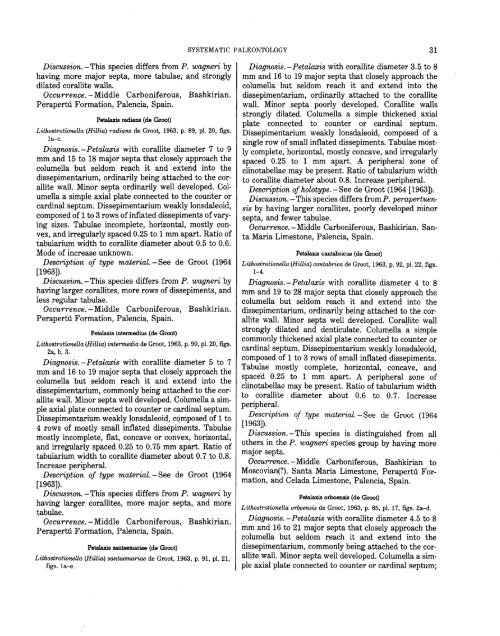Revision of Lithostrotionella - USGS
Revision of Lithostrotionella - USGS
Revision of Lithostrotionella - USGS
You also want an ePaper? Increase the reach of your titles
YUMPU automatically turns print PDFs into web optimized ePapers that Google loves.
SYSTEMATIC PALE ONTOLOGY 31<br />
Discussion.-This species differs from P. wagneri by<br />
having more major septa, more tabulae, and strongly<br />
dilated corallite walls.<br />
Occurrence.- Middle Carboniferous, Bashkirian.<br />
PerapertU Formation, Palencia, Spain.<br />
Petalaxis radians (de Groot)<br />
<strong>Lithostrotionella</strong> (Hillia) radians de Groot, 1963, p. 89, pl. 20, figs.<br />
la-c.<br />
Diagnosis.-Petalaxis with corallite diameter 7 to 9<br />
mm and 15 to 18 major septa that closely approach the<br />
columella but seldom reach it and extend into the<br />
dissepimentarium, ordinarily being attached to the corallite<br />
wall. Minor septa ordinarily well developed. Columella<br />
a simple axial plate connected to the counter or<br />
cardinal septum. Dissepimentarium weakly lonsdaleoid,<br />
composed <strong>of</strong> 1 to 3 rows <strong>of</strong> inflated dissepiments <strong>of</strong> varying<br />
sizes. Tabulae incomplete, horizontal, mostly convex,<br />
and irregularly spaced 0.25 to 1 rrim apart. Ratio <strong>of</strong><br />
tabularium width to corallite diameter about 0.5 to 0.6.<br />
Mode <strong>of</strong> increase unknown.<br />
Description <strong>of</strong> type material.-See de Groot (1964<br />
[1963])..<br />
Discussion. -This species differs from P. wagneri by<br />
having larger corallites, more rows <strong>of</strong> dissepiments, and<br />
less regular tabulae.<br />
Occurrence.- Middle Carboniferous, Bashkirian.<br />
Perapertu Formation, Palencia, Spain.<br />
Petalaxis intermedius (de Groot)<br />
<strong>Lithostrotionella</strong> (Hillia) intermedia de Groot, 1963, p. 90, pl. 20, figs.<br />
2a, b, 3.<br />
Diagnosis. -Petalaxis with corallite diameter 5 to 7<br />
mm and 16 to 19 major septa that closely approach the<br />
columella but seldom reach it and extend into the<br />
dissepimentarium, commonly being attached to the corallite<br />
wall. Minor septa well developed. Columella a simple<br />
axial plate connected to counter or cardinal septum.<br />
Dissepimentarium weakly lonsdaleoid, CQmposed <strong>of</strong> 1 to<br />
4 rows <strong>of</strong> mostly small inflated dissepiments. Tabulae<br />
mostly incomplete, flat, concave or convex, horizontal,<br />
and irregularly spaced 0.25 to 0. 75 mm apart. Ratio <strong>of</strong><br />
tabularium width to corallite diameter about 0. 7 to 0.8.<br />
Increase peripheral.<br />
Description <strong>of</strong> type material.-See de Groot (1964<br />
[1963]).<br />
Discussion. -This species differs from P. wagneri by<br />
having larger corallites, more major septa, and more<br />
tabulae.<br />
Occurrence.- Middle Carboniferous,_ Bashkirian.<br />
Perapertu Formation, Palencia, Spain.<br />
Petalaxis santaemariae (de Groot)<br />
<strong>Lithostrotionella</strong> (Hillia) santaemariae de Groot, 1963, p. 91, pl. 21,<br />
figs. la-e.<br />
Diagnosis.-Petalaxis with corallite diameter 3.5 to 8<br />
mm and 16 to 19 major septa that closely approach the<br />
columella but seldom reach it and extend into the<br />
dissepimentarium, ordinarily attached to the corallite<br />
wall. Minor septa poorly developed. Corallite walls<br />
strongly dilated. Columella a simple thickened axial<br />
plate connected to counter or cardinal septum.<br />
Dissepimentarium weakly lonsdaleoid, composed <strong>of</strong> a<br />
single row <strong>of</strong> small inflated dissepiments. Tabulae mostly<br />
complete, horizontal, mostly concave, and irregularly<br />
spaced 0.25 to 1 mm apart. A peripheral zone <strong>of</strong><br />
clinotabellae may be present. Ratio <strong>of</strong> tabularium width<br />
to corallite diameter about 0.8. Increase peripheral.<br />
Description <strong>of</strong> holotype.- See de Groot (1964 [1963]).<br />
Discu,ssion.- This species differs from P. perapertuensis<br />
by having larger corallites, poorly developed minor<br />
septa, and fewer tabulae.<br />
OccU'rrence.- Middle Carboniferous, Bashkirian. Santa<br />
Maria Limestone, Palencia, Spain.<br />
.Petalaxis cantabricus (de Groot)<br />
<strong>Lithostrotionella</strong> (Hillia) cantabrica de Groot, 1963, p. 92, pl. 22, figs.<br />
1-4.<br />
Diagnosis. -Petalaxis with corallite diameter 4 to 8<br />
mm and 19 to 28 major septa that closely approach the<br />
columella but seldom reach it and extend into the<br />
dissepimentarium, ordinarily being attached to the corallite<br />
wall. Minor septa well developed. Cora!lite wall<br />
strongly dilated and denticulate. Columella a simple<br />
commonly thickened axial plate connected to counter or<br />
cardinal septum. Dissepimentarium weakly lonsdaleoid,<br />
composed <strong>of</strong> 1 to 3 rows <strong>of</strong> small inflated dissepiments.<br />
Tabulae mostly complete, horizontal, concave, and<br />
spaced 0.2!5 to 1 mm apart. A peripheral zone <strong>of</strong><br />
clinotabellae may be present. Ratio <strong>of</strong> tabularium width<br />
to corallite diameter about 0.6 to 0.7. Increase<br />
peripheral.<br />
Description <strong>of</strong> type material.- See de Groot (1964<br />
[1963]).<br />
Discussion. -This species is distinguished from all<br />
others in the P. wagneri species group by having more<br />
major septa.<br />
Occurrence.- Middle Carboniferous, Bashkirian to<br />
Moscovian(!'). Santa Maria Limestone, Perapertu Formation,<br />
and Celada Limestone, Palencia, Spain.<br />
Petalaxis orboensis (de Groot)<br />
<strong>Lithostrotionella</strong> orboensis de Groot, 1963, p. 85, pl. 17, figs. 2a-d.<br />
Diagnosis. -Petalaxis with corallite diameter 4.5 to 8<br />
'mm and 16 to 21 major septa that closely approach the<br />
columella but seldom reach it and extend into the<br />
dissepimentarium, commonly being attached to the corallite<br />
wall. Minor septa well developed. Columella a simple<br />
axial plate connected to counter or cardinal septum;

















